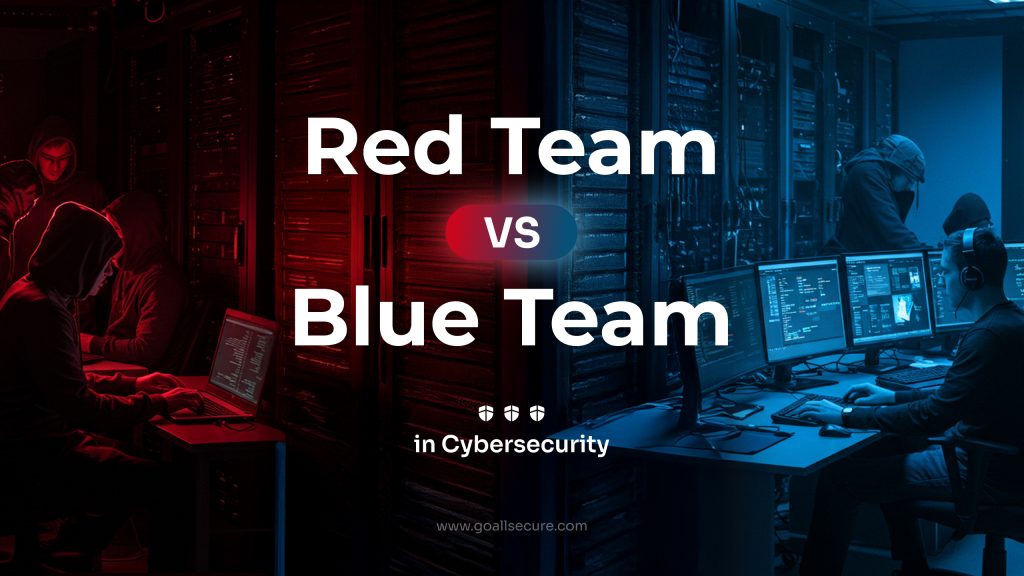The rate at which cyber crimes are growing today is alarming. Every 39 seconds, a cyber attack is launched, making the digital/online space very dangerous. To combat these evasive threats, the red and the blue teams exist. Both these teams consist of cyber security professionals who shield an organisation from cyber security attacks heading their way. While both teams are to protect from cyber threats, what makes them different are their approaches. The blue team is on the defensive side of security, meaning they work from inside the organisation. Their goal is to identify and neutralise the threats that are headed towards an organisation.
On the other hand, the red team works on the offensive side of cyber security. It tracks existing vulnerabilities and stimulates real-world attacks with the goal of strengthening an organisation’s security posture. In this blog, we will examine what these teams do and why they are necessary for any organisation. Come, let’s take a closer look at the way both of these teams operate and how they can be a great addition to an organisation’s security posture.
What Is Red Team and What Do They Do
Red team justifies the name it has been given after the colour red. They represent attacks and danger. Red teams specialise in being on the lookout for threats and vulnerabilities that could be exploited. These cyber security professionals are highly trained in thinking and reacting like real-life threat actors. They are laser-focused on getting into a system by manipulating any available vulnerability. Now, these vulnerabilities could be in the system or the people working for the organisation. The red team uses these opportunities to gain access to the system and, in the process, reveals the loopholes that need immediate attention.
For a red team to successfully do its work, there has to be a clear plan of action. The goal is to pick a specific area that needs to be tested against cyber attacks. After that is finalised, the red team perform offensive assessments like internal and external penetration testing, compromising wireless networks, physical access, social engineering techniques, strategic attack scenarios, credential brute-forcing, etc. The goal here is not just to break into a system but rather to provide valuable insights to the organisation’s blue team/ security team to patch and better protect the digital assets. Understanding where the security weaknesses lie and how to remain cyber resilient by addressing these vulnerabilities is a vital outcome of a successful red team assessment.
What Is Blue Team and What Do They Do
The blue team is like the first line of defenders who are always ready to protect an organisation’s network and security. Needless to say, they are on the defensive side of cyber security. Blue teams are responsible for maintaining the security posture of the organisation against any and all possible cyber attacks. An organisation’s information technology systems, networks, data protection, etc., fall under the protection of this team. The dedicated tasks of a blue team are several, to name some: threat monitoring and detection, incident response, vulnerability management, security awareness and training, etc.
Blue team’s work is not time-specific but rather an ongoing process. From setting up security parameters to regular upkeep and hardening of the network and security posture, everything falls on their shoulders. These cyber security professionals are well equipped to protect an organisation from dangerous attacks and are always prepared to defend in case of a cyber security incident. One of the most extensive responsibilities they shoulder is making sure every employee has a basic awareness of cyber security to avert any insider threats. The blue team’s role is essential for maintaining the overall cybersecurity posture of an organisation. They aim to prevent security incidents and, if they occur, respond effectively to minimise the possible damage. By continually assessing and enhancing security measures, blue teams help protect sensitive data and ensure the confidentiality, integrity, and availability of an organisation’s IT assets.
Red Team vs Blue Team: What Makes Them Different From Each Other?
Well, there is a prominent trait that separates the red and blue teams, which is their approach to cyber security. While the blue team plays on the defensive side, the red goes for the offensive. But in this section, we will elaborate on these differences, from their area of expertise to their methodologies.
AREA OF EXPERTISE
| Blue Team | Red Team |
| Monitoring And Analysis | Testing Perimeter Security |
| Incident Response | Threat And Risk Analysis |
| Vulnerability Management | Penetration Testing |
| Training And Education | Reporting And Recommendations |
SECURITY MEASURES AND METHODOLOGIES
| Red Team | Blue Team |
| Exploiting Web Applications | End Point Security |
| Open Source Intelligence Gathering | Configuration Audits |
| Social Engineering | Logging And Monitoring |
| Network Attacks | Security Control Review |
| Physical Security Testing | Network Segmentation |
SPECIFIC TOOLS USED
| Red Team | Blue Team |
| Amass- Attack Surface Mapping | The Sleuth- Kit Disk images analysis tools |
| truffleHog- Github Regex Search | Autopsy- Digital forensics platform |
| Linkedin UserEnum- Linkedin Employee Profile Scrapper | VirusTotal- Malicious IOC Sharing Platform |
| o365Spray- Username enumeration and password spraying | Lookyloo- Phishing domain mapping |
| Evilnginx2- to bypass of 2-factor authentication | YARA Malware identification via pattern matching |
| Cobalt Strike- a commercial penetration testing tool | Sysmon- System Monitor for Windows |
| Merlin- cross-platform post-exploitation HTTP/2 Command & Control server and agent | Kibana- Data visualization and exploration |
| Sliver- Adversary Emulation Framework | Logstash- Data collection and processing |
| ProxyCannon- A private botnet using multiple cloud environments | Parsedmarc- Email DMARC data visualisation |
| Seatbelt- Ghostpack | Phishing Catcher- Phishing catcher using Certstream |
| pickl3- Windows active user credential phishing tool | Maltrail- Malicious traffic detection system |
| CredPhisher- Advanced phishing tool used for session & credential grabbing | AutorunsToWinEventLog- Windows AutoRuns Event Parser |
| Mimikatz- extract passwords and credentials from a system’s memory. | procfilter YARA-integrated process denial framework |
| SharpMiniDump- Uses dynamic API calls, direct syscall and Native API unhooking to evade the AV / EDR detection | SysmonSearch- Sysmon event log visualisation |
| Pypykatz- Python implementation of Mimikatz | yarGen- YARA rule generator |
| LOLBAS- Living Off The Land Binaries, Scripts and Libraries | Chainsaw- Fast Windows Forensic Artefacts Searcher |
| SharpBlock- bypassing EDR’s active projection DLL’s by preventing entry point exection | filesec.io- Attacker file extensions |
| ScareCrow- EDR Bypass Payload Creation Framework | Unprotect Project Malware- evasion techniques knowledge base |
How They Work Together to Provide the Ultimate Cyber Security?
Both the blue team and the red team are significant assets on their own, but when put together, they are unstoppable. That is why it is always beneficial for organisations to have both of them and keep conducting their joint operations. In the case of joint cyber security exercises, the blue team collaborates with the red team. The red team tries to exploit vulnerabilities, and the blue team defends against these attacks. This exercise helps organisations test and improve their security defences. Red and blue team collaboration, called “purple teaming,” is a valuable approach to enhancing cyber security. Here’s how this collaboration leads to better cyber protection:
- By working together, the teams can conduct more realistic assessments of an organisation’s security defences. This helps in identifying vulnerabilities and weaknesses that may be skipped in traditional testing.
- Their collaboration encourages the sharing of knowledge and expertise. Red team members can provide insights into the latest attack techniques and tactics. In contrast, the blue team can share their understanding of the organisation’s systems and defences.
- Purple teaming exercises provide the opportunity to receive immediate feedback and quick remediation. Red team members can explain how they gained access or exploited vulnerabilities, while the blue team can understand the shortcomings and improve their defence strategies.
- Being able to create customised defence strategies has to be a top benefit. The joint exercise provides room to adopt a tailored approach to defence. This helps in effectively mitigating specific risks.
- By working together, both teams contribute to a culture of continuous improvement in cyber security posture. The organisation can adapt and evolve its security measures based on the lessons learned from each collaboration.
In summary, the collaboration between red and blue teams is a proactive and effective way to strengthen an organisation’s cyber security. It promotes a holistic and continuous improvement approach to security that is essential in an ever-evolving threat landscape. With GoAllSecure, you will receive the best of both worlds. We have expert red and blue teamers ready to disintegrate every threat. Get comprehensive and top-tier security services and solutions with us. Feel free to get in touch with our team for your cyber security needs. We have all the resources to defend you against threats. For more information about us, kindly call us at +91 85 2723 7851 or +44 20 3287 4253.

















 TRAVEL & HOSPITALITY
TRAVEL & HOSPITALITY HEALTHCARE
HEALTHCARE RETAILS & ECOMMERCE
RETAILS & ECOMMERCE BANKING & FINANCIAL
BANKING & FINANCIAL AutoMobile
AutoMobile MANUFACTURING
MANUFACTURING FOOD
FOOD EDUCATION
EDUCATION



